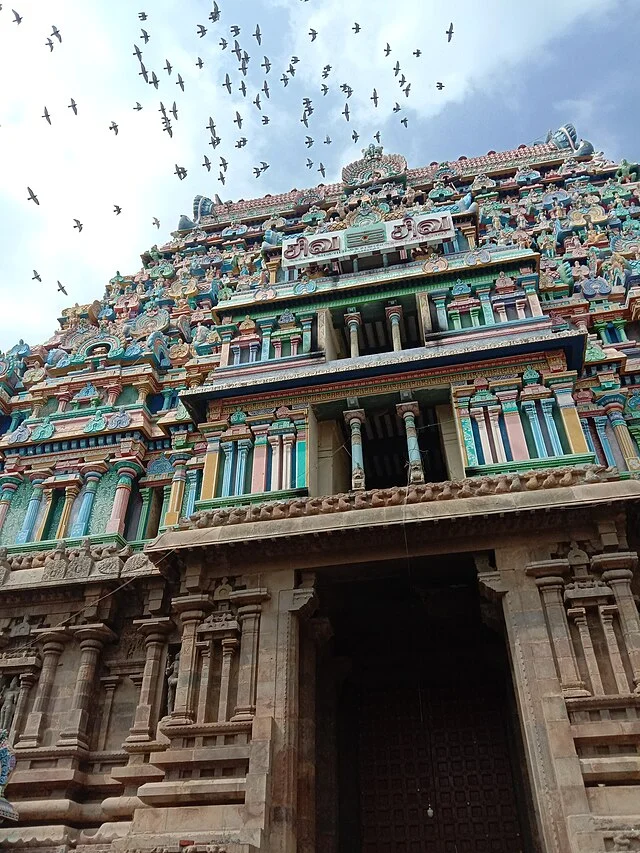The Thiruvarur Thiyagarajar Temple, located in Tamil Nadu, India, is one of the oldest and most significant Hindu temples in South India. This temple, dedicated to Lord Shiva in the form of Thiyagarajar, is renowned for its architectural complexity, historical significance, and intricate rituals. It stands as a testament to the Chola dynasty’s dedication to religious and cultural excellence, with records dating back to at least the 9th century AD.
Get your dose of History via Email
Historical Background

The Thiruvarur temple complex has a history rooted in the early Chola period. Inscriptions suggest construction began in the 9th century AD under the rule of Chola king Aditya I (871–907 AD). Subsequent rulers, especially Raja Raja Chola I (985–1014 AD), contributed greatly to the temple’s development, making Thiruvarur a significant religious center. Chola rulers used temples as focal points for art, culture, and religious practices, and this temple became a primary site for promoting the worship of Shiva.
Over the centuries, rulers from the Pandya, Vijayanagara, and Nayaka dynasties also supported the temple, enriching its design and rituals. Each dynasty added its unique touch, contributing to the complex layers of architecture and inscriptions present today.
Architectural Highlights
The Thiruvarur Thiyagarajar Temple complex is vast, covering around 20 acres. Its design follows the traditional Dravidian architectural style, featuring towering gateways (gopurams), pillared halls (mandapas), and intricately carved sanctuaries.
1. Gopurams
The temple’s gopurams, or monumental entrance towers, are significant landmarks. The eastern gopuram, the tallest, rises over 118 feet and showcases elaborate sculptures depicting mythological scenes. These towering gateways symbolize the cosmic mountains, an essential aspect of Dravidian temple architecture.
2. Kamalalayam Tank
One of the largest temple tanks in India, the Kamalalayam tank, is part of the Thiruvarur temple complex. This massive water body holds sacred status in Hinduism and serves as the central focus during annual festivals, particularly the Panguni Uthiram festival. Devotees believe that bathing in the tank purifies and absolves them of sins.
3. Sanctum and Deity
The main deity, Thiyagarajar, represents a unique form of Lord Shiva, depicted in the “Somaskanda” style (Shiva with his consort Parvati and son Skanda). The deity is considered to possess special spiritual energy. According to temple lore, the idol of Thiyagarajar was a divine gift from Lord Indra, the king of the gods.
This temple is part of the Saivite tradition, where Shiva is worshiped as Thiyagarajar, or “King of Sacrifice.” Unlike typical Shiva temples where the deity appears as a linga, here Shiva is presented in human form, dancing the Ajaba Natanam (dance without chanting).
Cultural and Religious Practices
Thiruvarur Thiyagarajar Temple is notable for its unique rituals, including the Ajaba Natanam. This ritual dance symbolizes cosmic creation and destruction and is distinct to the Thiyagarajar deity. Additionally, the temple practices daily pujas, special abhishekams, and the worship of the goddess Kamalambal, Thiyagarajar’s consort.
Musical Tradition
Thiruvarur holds a revered place in Carnatic music history. The town produced prominent Carnatic music composers, often referred to as the “Trinity of Carnatic Music”: Tyagaraja, Muthuswami Dikshitar, and Syama Sastri. Dikshitar’s compositions frequently reference the Thiyagarajar deity, illustrating the deep spiritual and cultural connection between music and temple worship.
Festivals
The annual Panguni Uthiram festival in March-April draws thousands of pilgrims. This 10-day festival features the chariot (rath) procession, one of the largest and heaviest temple chariots in India, weighing approximately 300 tons. Pulled by devotees through the streets of Thiruvarur, the chariot displays the Thiyagarajar deity and is believed to bring blessings to those who witness it.
Another major festival, the Arudra Darisanam, celebrates the cosmic dance of Shiva. Observed in December-January, it features special rituals and ceremonies dedicated to Thiyagarajar and the goddess Kamalambal.
Inscriptions and Historical Documentation
The temple houses over 80 inscriptions that provide insights into the region’s history, patronage, and cultural developments. These inscriptions date back to the Chola period and cover topics from temple donations to royal decrees on land ownership and labor distribution. They serve as valuable resources for understanding Chola governance and religious practices.
Conclusion
The Thiruvarur Thiyagarajar Temple is a center of religious worship, cultural history, and architectural splendor. With origins in the Chola dynasty, the temple reflects Tamil Nadu’s rich heritage and dedication to Shiva worship. It stands as a monument to the Cholas’ architectural prowess, religious devotion, and commitment to the arts.
As a living temple with active rituals, festivals, and musical traditions, Thiruvarur Thiyagarajar continues to be an important site for Hindu worship and an inspiring location for historians and archaeologists alike. The temple’s blend of spirituality, history, and culture ensures its status as a heritage site that continues to attract reverence and scholarly interest worldwide.
Source:

